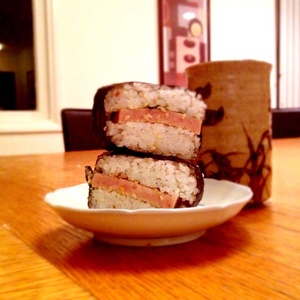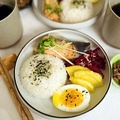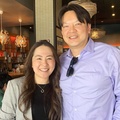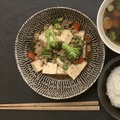Today I’m going to talk about Spam. I’m not talking about the kind in your online mailbox, I’m talking about the canned meat.
Hey, where’d everybody go?
Now that everyone, save for a few adventurous souls and the Asians, have left the room let me tell you about one of my favorite family traditions, Spam musubi, (pronounced moo-soo-bee), a kind of sushi concoction made out of Spam, rice, and seaweed.
Hey look—now only the Asians are still here.
Sure, being Japanese-American, everyone expects that my family tradition would be along the lines of a complex fish recipe handed down to me from my grandmother and featuring eyeballs and fins, or some sort of elegant cake concoction made from the delicate leaves of a young cherry blossom tree. Ideally it would be something that was created by my ancestors and whose ingredients were painstakingly written down on a piece of parchment and residing in an antique carved wooden box that smells like memories.
Instead, it’s a meat of questionable origin, plopped out of a rectangular can along with its glistening, quivering coating of gelatin. Then it’s sliced, sautéed, and sandwiched between some rice and wrapped in seaweed. It doesn’t so much smell like memories as like ham.
Here, see for yourself:
More than a tradition, it’s a constant presence whenever my huge family of 30 gets together. Unlike my mom’s lime-green jello that only makes an appearance at Thanksgiving, Spam musubi shows up at birthday parties, Christmas dinner, picnics, graduation celebrations, Easter brunch, and even funerals. Usually my mom makes a platter of Spam musubi, but since its recipe is universal anyone can step in and whip up a batch. Unlike other more glamorous, gourmet holiday dishes, cousins, sister-in-laws, aunts, and uncles all possess the culinary skill to bring these beauties to the table. Take that, white-truffle-oil fingerling potatoes.
I particularly enjoy serving Spam musubi to my non-Asian friends at gatherings and parties. Not so much because I have a need to share the culinary customs of my culture, but because it’s just a laugh riot seeing their faces when they realize it’s—meat from a can. There they are, innocently reaching for that square-ish piece of seaweed-cloaked rice, expecting a delicacy like they just had at their date-night sushi bar. Right at that moment I like to ask, “Do you know what that is?” After the truth is revealed, the strongest will forge ahead and pop that bad boy right into their mouths, while the weaker ones will seek out more familiar territory. That’s why buffalo wings were invented.
One of the best things about Spam musubi is its ease of preparation. All it takes is some cooked (Japanese) rice, a few sheets of seaweed, a little soy sauce, and a humble can of Spam. A quick Google search will find you a bounty of recipes, and a Spam musubi mold can be found in any Japanese market. Better yet, I love this awesome idea of using the Spam can as a mold. Pure genius—food that comes with its own cooking utensil? I’d like to see organic wild pheasant make that same claim.
(It’s not just my family tradition—Spam musubi can be found at many Japanese restaurants and all over Hawaii, where they even sell them at 7-11. Being able to walk into a convenience store and pick up a Spam musubi and a Big Gulp might just be the best reason I’ve ever heard for moving to Maui.)
So if you’re ever lucky enough to be at one of my family gatherings, I encourage you to look past the sashimi platter, the pans of homemade lumpia, and the bowls of kimchi (sitting right next to the deep-fried turkey, the Easter ham, and the foot-long hoagie) and seek out the true essence of my Japanese-American cuisine culture—the square Tupperware filled with neat rows of Spam musubi. Now there’s a dish steeped in tradition. And gelatin.
A version of this story was originally published on Yahoo! Shine on Dec. 1, 2010.
© 2012 Marsha Takeda-Morrison







